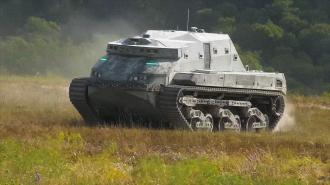DARPA just tested an autonomous tank that could help keep soldiers safe — and even more self-driving military vehicles are on the horizon. If autonomous vehicles prove capable enough for the battlefield, the tech could someday start finding its way over to civilian uses, too.
The challenge: Tanks have played an important role in the US military for more than 100 years, thanks to their tremendous firepower and armor, but every time the Army puts a soldier into a tank and sends them into combat, it’s putting their life at risk.
Even if the tank is never attacked by an enemy, there’s some evidence that simply firing a tank can cause brain damage for the operators inside, potentially leading to problems with cognition and mental health.
An autonomous tank: In 2020, DARPA launched the Robotic Autonomy in Complex Environments with Resiliency (RACER) program to develop algorithms capable of controlling tanks and other off-road military vehicles.
In March 2023, it completed the first tests of these algorithms in uncrewed RACER Fleet Vehicles (RFVs), which look like seriously souped up four wheelers. Now, it has started testing them in a larger, tank-like vehicle it’s calling the “RACER Heavy Platform” (RHP).
The first tests of DARPA’s autonomous tank took place at military training areas in Texas at the end of 2023, according to a press release. During them, the vehicles drove themselves for more than 30 miles in an “autonomous-route-following-mode.”
This gave DARPA researchers the opportunity to collect sensor data, test the RACER algorithms in a new vehicle, and assess the RHP’s mobility over complex terrain.
“[These activities are] setting the tone for the program to achieve tougher autonomous maneuver goals while showing autonomy resiliency and adaptability to new environments on any robot at any scale,” said Stuart Young, RACER program manager.
The 12-ton, 20-foot-long RHP is small compared to a US military tank (the 42-ton M10 Booker is considered a “light tank”), but DARPA says the research platform is similar in size to autonomous combat vehicles that are in development.
Its plan now is to continue testing and developing the autonomous tank throughout 2024, conducting two more field experiments before the end of the year.
The big picture: Tanks aren’t the only vehicles the US military wants to automate. While the RACER program focuses on ground vehicles, another DARPA program, ACE, is developing an AI fighter pilot — it just controlled a jet during a real dogfight scenario.
Meanwhile, DARPA’s Manta Ray program is developing an autonomous underwater drone that could be used for surveillance — a full-scale prototype of it just completed its first in-water testing off the California coast in February and March 2024.
“There has been a revolution in the techniques and capabilities of uncrewed ground vehicles.”
Kevin O’Brien
More autonomous ground vehicles are coming, too.
In April 2024, the Army teamed up with the DoD’s Defense Innovation Unit (DIU) to launch the Ground Vehicle Autonomous Pathways (GVAP) project. They’ve partnered with eight private companies to develop software capable of controlling military vehicles on the ground.
“There has been a revolution in the techniques and capabilities of uncrewed ground vehicles occurring in the private sector over the past two decades,” said Kevin O’Brien, technical director for the DIU’s Autonomy Portfolio. “We’re eager to bring these matured technologies back into the Department of Defense.”
We’d love to hear from you! If you have a comment about this article or if you have a tip for a future Freethink story, please email us at tips@freethink.com.
